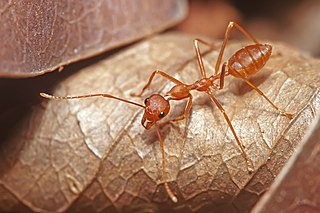
The large blue is a species of butterfly in the family Lycaenidae. The species was first defined in 1758 and first recorded in Britain in 1795. In 1979 the species became mostly extinct in Britain but has been successfully reintroduced with new conservation methods. The species is classified as "near threatened" on the IUCN Red List of Threatened Species. Today P. arion can be found in Europe, the Caucasus, Armenia, western Siberia, Altai, north-western Kazakhstan and Sichuan.

The common blue butterfly or European common blue is a butterfly in the family Lycaenidae and subfamily Polyommatinae. The butterfly is found throughout the Palearctic and has been introduced to North America. Butterflies in the Polyommatinae are collectively called blues, from the coloring of the wings. Common blue males usually have wings that are blue above with a black-brown border and a white fringe. The females are usually brown above with a blue dusting and orange spots.

Lycaenidae is the second-largest family of butterflies, with over 6,000 species worldwide, whose members are also called gossamer-winged butterflies. They constitute about 30% of the known butterfly species.

The blue ant, also known as the blue-ant or bluebottle, is a species of flower wasp in the family Thynnidae. It is the sole member of the genus Diamma and of the subfamily Diamminae. Despite its common name and wingless body, it is not an ant but rather a species of large, solitary, parasitic wasp.

Phengaris alcon, the Alcon blue or Alcon large blue, is a butterfly of the family Lycaenidae and is found in Europe and across the Palearctic to Siberia and Mongolia.

Oecophylla smaragdina is a species of arboreal ant found in tropical Asia and Australia. These ants form colonies with multiple nests in trees, each nest being made of leaves stitched together using the silk produced by the ant larvae: hence the name 'oecophylla' [Greek for 'leaf-house'].

Illidge's ant-blue butterfly, is an endangered species of butterfly endemic to Australia. This species can be found at six confirmed sites: Mary River Heads, Beaver Rock and Maaroom in the Fraser Coast Region (Queensland); Redland Bay and Point Halloran in the City of Redland (Queensland), and Brunswick Heads.

The grey ant-blue is a butterfly native to Australia.

Acrodipsas is a genus of butterflies in the family Lycaenidae. There are ten species in this genus all endemic to the Australasian realm:
The Geelong Field Naturalists Club (GFNC) is an Australian regional amateur scientific natural history and conservation society which was founded in 1961 by Trevor Pescott. It is based in Geelong, Victoria, with the aims of:

Jalmenus evagoras, the imperial hairstreak, imperial blue, or common imperial blue, is a small, metallic blue butterfly of the family Lycaenidae. It is commonly found in eastern coastal regions of Australia. This species is notable for its unique mutualism with ants of the genus Iridomyrmex. The ants provide protection for juveniles and cues for adult mating behavior. They are compensated with food secreted from J. evagoras larvae. The ants greatly enhance the survival and reproductive success of the butterflies. J. evagoras lives and feeds on Acacia plants, so butterfly populations are localized to areas with preferred species of both host plants and ants.

Acrodipsas cuprea, the copper ant-blue or cuprea ant-blue, is a butterfly of the family Lycaenidae. It is found in Australia, from southern Queensland to Victoria.

Acrodipsas myrmecophila, the small ant-blue, is a butterfly of the family Lycaenidae. It is found in the south-east of Australia.

Acrodipsas arcana, the black-veined ant-blue or arcana ant-blue, is a butterfly of the family Lycaenidae. It is found inland on hills in southern Queensland and northern New South Wales in Australia.

Acrodipsas aurata, the golden ant-blue, is a butterfly of the family Lycaenidae. It is found in the mountains of New South Wales and northern Victoria in Australia.
Acrodipsas decima, the Decima ant-blue, is a butterfly of the family Lycaenidae. It is found in a small area of the Northern Territory in Australia.
Acrodipsas hirtipes, the hirtipes ant-blue or black ant-blue, is a butterfly of the family Lycaenidae. It is found in the Northern Territory and on the Cape York Peninsula in Australia.
Acrodipsas mortoni, the brown ant-blue, is a butterfly of the family Lycaenidae. It is found in inland New South Wales and southern Queensland in Australia.
This page is based on this
Wikipedia article Text is available under the
CC BY-SA 4.0 license; additional terms may apply.
Images, videos and audio are available under their respective licenses.












